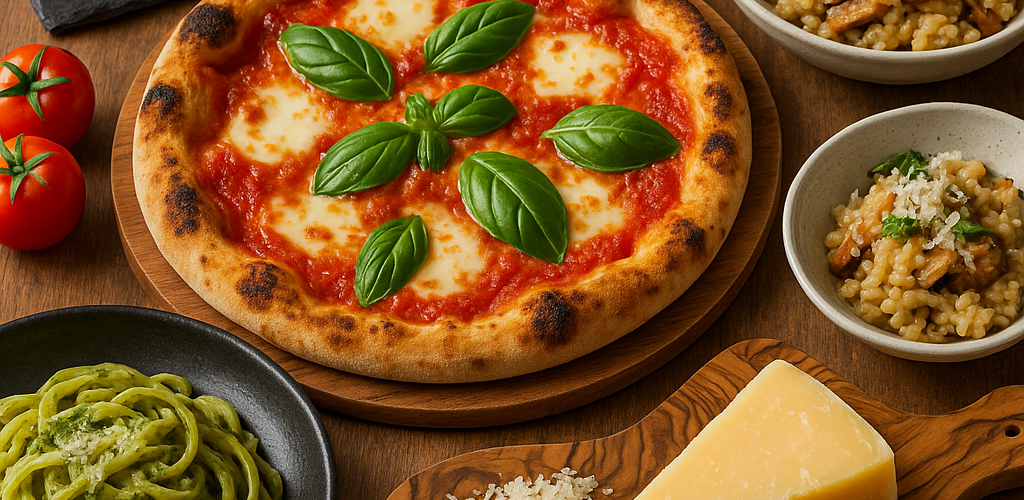Italian Restaurants in India: Are They Authentic?

Italian cuisine ranks among the most beloved food traditions worldwide. In India, where culinary diversity runs deep, Italian food has gained immense popularity over the past two decades. From creamy pastas and wood-fired pizzas to decadent tiramisus and risottos, Italian dishes have found a permanent place in urban food culture. But the real question remains: Are Italian restaurants in India truly authentic?
To answer this, we need to break down what defines authenticity in Italian food and how Indian eateries adapt or modify it to suit local tastes.
What Defines Authentic Italian Cuisine?
Authentic Italian food celebrates simplicity, high-quality ingredients, and traditional cooking methods. Most dishes originate from specific regions in Italy—Tuscany, Sicily, Lombardy, and Emilia-Romagna to name a few. Each area emphasizes local ingredients like tomatoes, olives, cheeses, and seafood, paired with a minimalist approach that lets the core flavors shine.
For example:
- A traditional Neapolitan pizza uses San Marzano tomatoes, fresh mozzarella, and a chewy, charred crust baked in a wood-fired oven.
- An authentic Carbonara contains only guanciale, Pecorino Romano, eggs, and black pepper—never cream.
- Risotto alla Milanese requires Arborio rice, saffron, and beef stock, cooked slowly with frequent stirring.
True Italian cooking avoids overcomplicating things. So any deviation from these essentials starts raising authenticity concerns.
Italian Restaurants in India: What’s the Reality?
Walk into any major city in India—Mumbai, Delhi, Bangalore, Pune, or Chennai—and you’ll find Italian-themed restaurants ranging from budget-friendly cafés to upscale fine-dine venues. But do they stick to Italy’s culinary roots?
1. Ingredient Substitutions
Most Indian Italian restaurants replace imported ingredients with local alternatives. While some do it due to cost constraints, others do it to cater to local palates.
For instance:
- Mozzarella di Bufala gets replaced by processed mozzarella or Amul cheese.
- Instead of guanciale or pancetta, chefs use bacon or chicken.
- Basil may get swapped with coriander in some fusion variations.
- San Marzano tomatoes, prized for their sweetness, rarely appear—canned or hybrid Indian varieties take their place.
Such substitutions compromise the original flavor profile of Italian dishes. While the result may still taste good, it doesn’t represent Italy’s culinary tradition.
2. Fusion Overload
Many restaurants in India introduce a “masala twist” to Italian dishes. Spicy paneer pizzas, makhani pasta, tandoori mushroom lasagna, and butter chicken ravioli may delight customers, but they stray far from authenticity.
Chefs often fuse Italian and Indian flavors to attract a wider audience. While these hybrid dishes find success, they dilute the essence of Italian cooking. Authenticity takes a backseat when the goal becomes mass appeal.
3. Use of Cream in Pasta
Cream-based pastas dominate most Italian menus in India. Dishes like “white sauce pasta,” “cheesy Alfredo,” and “chicken cream penne” remain restaurant staples. But in Italy, traditional pasta sauces rely on olive oil, cheese, tomatoes, eggs, and butter—not heavy cream.
Indians love rich, creamy textures, and restaurants cater to that preference. The result? Carbonaras with cream, pestos with mayonnaise, and Bolognese sauces with chili powder.
4. Cooking Techniques
In Italy, pasta always gets cooked al dente—firm to the bite. In India, many restaurants overcook pasta to meet local preferences. Similarly, pizzas often use electric or gas ovens rather than wood-fired ovens, affecting texture and taste.
Also, portion sizes in Italy remain small and balanced, focusing on flavor and freshness. In contrast, Indian restaurants often serve large, indulgent portions.
Restaurants That Get It Right
Not all Italian restaurants in India sacrifice authenticity. Several fine-dining establishments take great care to replicate traditional Italian cooking. They import ingredients, hire trained chefs, and invest in proper cooking equipment.
Here are some that stand out:
1. Artusi Ristorante (Delhi and Gurgaon)
Named after Pellegrino Artusi, the father of modern Italian cuisine, Artusi brings the rich flavors of Northern Italy to India. The chefs use Italian cheeses, flours, and cold cuts. Pastas are hand-rolled, and the risottos meet Italian texture standards.
2. CinCin (Mumbai)
CinCin focuses on fresh pasta, wood-fired pizzas, and Italian aperitifs. With a seasonal menu, authentic ingredients, and chefs trained in Italy, CinCin offers a close-to-Italy experience without gimmicks.
3. Toscano (Bangalore, Chennai)
This long-standing Italian eatery chain uses authentic ingredients and sticks to Italian culinary methods. From gnocchi to tiramisu, Toscano’s menu avoids fusion twists and focuses on regional Italian integrity.
4. La Piazza at Hyatt Regency (Delhi)
One of the pioneers of authentic Italian dining in India, La Piazza has an open kitchen and a wood-fired oven. Their menu avoids shortcuts, and the chefs work under direct Italian supervision.
Why Full Authenticity Remains Rare
Even in upscale restaurants, 100% authenticity remains hard to achieve. Imported ingredients come with hefty price tags and limited availability. Diners often prefer localized flavors, pushing chefs to alter recipes. Also, hiring Italian chefs or training Indian ones takes time and investment.
Some restaurants face criticism when they stay too authentic—customers expect spice or “Indianised” twists and end up disappointed. So even places with the best intentions may bend rules to survive.
How to Spot a Truly Authentic Italian Restaurant
Want to eat genuine Italian food in India? Look out for these signs:
- Short, focused menu: Real Italian places don’t serve 100 items. They do a few things really well.
- Ingredient transparency: Look for dishes that list specific cheeses (Parmigiano Reggiano, Pecorino), meats (prosciutto, pancetta), and pasta types.
- Cooking methods: Check if they cook pasta al dente, use extra virgin olive oil, and avoid cream in Carbonara.
- No ketchup or fusion items: If the menu features butter chicken pasta or Schezwan pizza, authenticity isn’t the priority.
- Wine pairings and imported olive oils: Real Italian meals pair with wine and good-quality oils—not synthetic substitutes.
Final Thoughts
Indian Italian restaurants often serve delicious food, but most fall short of true authenticity. They bend the rules to fit local tastes, cost restrictions, and market demands. However, a growing number of diners now seek original flavors, pushing select restaurants to step up their game.
If you’re a purist or a traveler looking for Italy on a plate, seek out restaurants that prioritize quality, simplicity, and tradition over spicy fusion trends. While not always easy to find, authentic Italian dining experiences do exist in India—and they’re absolutely worth it.













